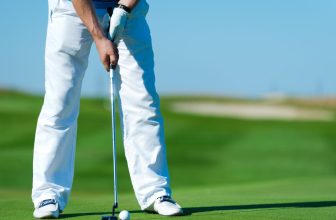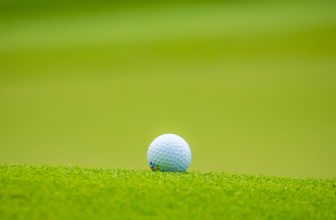
I first discovered this device at the PGA Show and have been very impressed. It comes with two devices – one to help with arm structure and the other to help with wrist movements.
The Arm Alarm ensures your arms are staying connected to avoid the chicken wing or flying elbow. If you make one of these mistakes, the device will beep and provide feedback on what part of the swing it’s happening.
The Wrist Alarm will help you understand if you flip or scoop the golf ball. You wear these devices on your wrist and can hit balls for a lot more effective practice sessions.
FAQs About Wrists Positions
If you want to learn even more about how the wrists move and work in the golf swing, check out the top questions and answers below.
Can you play golf with a cupped wrist? Is a cupped wrist bad?
Yes, you can, and a lot of amateur golfers do. However, most coaches would agree this position is only making golf harder as it leads to a loss of power, slicing the ball, and less consistency with ball striking. A slight amount of cupping is okay as players like Will Zalatoris and even Rory McIlroy play from this position, but most amateurs overdo it.
This is why it’s a good idea to improve your wrist position for a flat wrist and maybe even a bowed left wrist. This will usually take some time at the range, lessons with an instructor, or a wrist trainer to get comfortable with this move.
What is the opposite of a cupped wrist in golf?
The opposite of a cupped wrist in golf is a bowed wrist. A bowed wrist makes it easier to get into proper impact with forward shaft lean to compress the ball properly. Some of the best examples of players with a bowed wrist include Dustin Johnson, Brooks Koepka, and Colin Morikawa.
Did Hogan cup his left wrist?
Yes, Ben Hogan did cup his left wrist. A lot of golfers like Colin Morikawa or Victor Hovland bow their wrist and a lot of players keep bowing on the downswing.
According to the same Golf Digest mentioned earlier, “This, Miller explains, was Hogan’s secret. He had a weak grip and cupped left wrist at the top of his swing, and as he swung through, Miller said his flexing of his lead wrist prevented him from rolling the clubface closed too quickly.”
Does a cupped wrist cause a hook?
No, a cupped wrist leads to a slice – one of the most common shots in golf. Most amateur golfers have a wrist that is too cupped, not too bowed. A bowed wrist leads to the clubface getting closed at impact, which leads to a draw and sometimes a hook.
Should I golf if my wrist hurts?
It’s not a good idea and would advise you to take time off to properly heal your wrist. Since golf requires you to hit down into the ground on most shots, this makes a wrist injury even worse. Make sure to use ice/heat, stretch, and physical therapy to heal your wrist before playing golf.
Wrapping Up
The cupped left wrist is a common challenge faced by many golfers, so if you’re in this spot now, just know you’re not alone. Understanding proper wrist position for both the lead and trail wrist can do wonders to your game.
When you have a consistent setup – with a neutral or strong grip – and understand the wrists, you’re on your way to more consistency. By incorporating the best training aids when hitting golf
balls and dedicating time to develop the correct muscle memory, you can make significant improvement in fixing a cupped left wrist.
Remember, improving your golf swing is a constant journey.
It’s a continuous process of learning, refining, and mastering the intricacies of the proper sequence. Embrace the challenge, stay committed to getting better every time you practice, and watch as your golf game transforms with the correction of the cupped left wrist.
Do you struggle with a cupped wrist?
Let us know in the comments below.





